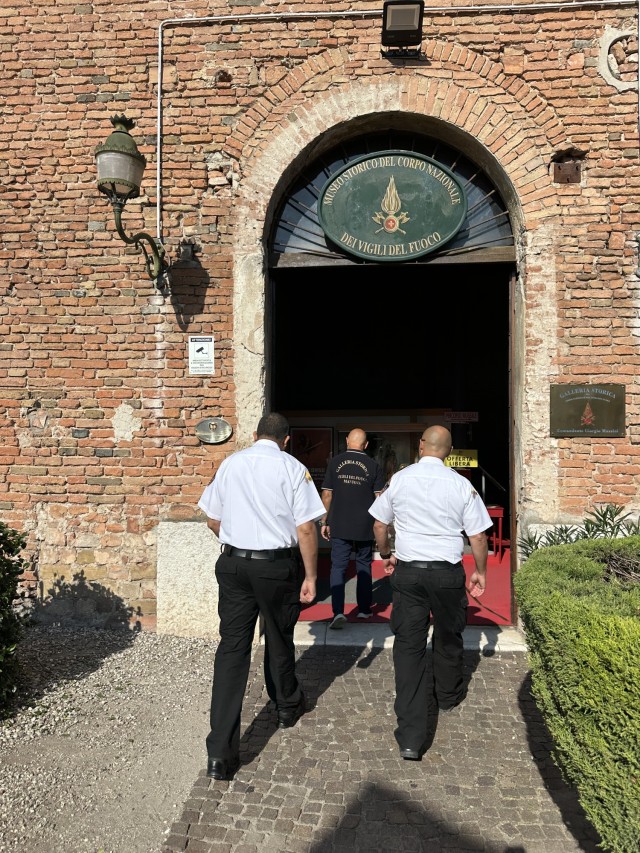MANTUA, Italy - Inside the majestic walls of Mantua’s Ducal Palace—a crown jewel of Italy’s Renaissance heritage—history comes alive through steel ladders, antique fire engines, and the worn leather of vintage helmets. Once the residence of the Gonzaga family, the palace also houses one of the country’s most compelling tributes to public service: the Italian National Historical Museum of the Firefighters, or Vigili del Fuoco.

The U.S. Army Garrison Italy firefighter command team made the one-hour drive to visit the museum Sept. 19, drawn by a shared mission and a symbolic connection—the 9/11 exhibit, featuring equipment and gear on loan from Caserma Ederle’s fire station in Vicenza.
“What stood out most was the extraordinary pride and meticulous care that went into preserving, restoring, and displaying the historical artifacts,” said Adam Montoya, fire chief of USAG Italy’s Directorate of Emergency Services.

“The museum is a testament to the dedication of the Italian fire service in honoring its rich history. It was deeply moving to see how the legacy of firefighting has been safeguarded for future generations, ensuring that the origins and evolution of our profession remain alive and accessible.”
What began in 1991 as a modest historical gallery has grown into a nationally recognized exhibition space, officially designated in 1994. Housed within the former stables and the theater of the palace, the museum spans four interconnected rooms, each offering a unique glimpse into the evolution of firefighting—from the rudimentary tools of the 18th century to the advanced equipment of today.

Giorgio Tedoldi, vice president of the Mantua firefighters’ retiree association that oversees the museum, welcomed the Vicenza team and shared his appreciation for its mission.
“This museum is a true gem—not just nationally, but beyond,” he said. “It celebrates the spirit of our profession. We are firefighters, devoted to serving the public, and we believe strongly in our mission. Understanding our history is essential, because without it, we cannot shape a meaningful future.”

Tedoldi also noted that entrance to the museum is free, making it accessible to all. This year alone, it welcomed 25,000 visitors, including 2,500 school students—a testament to its educational value and community impact.
Beyond its role as a museum, Tedoldi note that the collection serves as a resource for historical reenactments and film productions, with select artifacts—including perfectly functioning vintage vehicles—regularly loaned out to support cultural events and cinematic storytelling.

For the visiting team from USAG Italy, the museum was more than a historical excursion—it was a moment of reflection, connection, and professional inspiration.
Montoya emphasized its value for those in the fire service, describing it as a bridge between past and present.
“I wholeheartedly recommend visiting the museum, especially for those in the fire service,” he added. “It offers a rare and invaluable opportunity to witness the progression of our profession through the centuries. The exhibits trace firefighting history all the way back to Roman times, when the first fire codes were established, and showcase an impressive array of response vehicles—from bicycles and amphibious units to helicopters and fire trucks. One of the highlights is the only Alfa Romeo fire truck in existence, a truly unique piece of history. This museum not only educates but inspires, reminding us of the innovation and resilience that define our profession.”
Fernando Carrasco, assistant chief of operations with DES, echoed Montoya’s sentiments, focusing on the museum’s ability to connect visitors with the roots of the fire service.

“What I enjoyed most about the visit was the historical aspect and learning about the origins of the traditions of the fire service,” Carrasco said. “I believe people should visit the museum to gain an appreciation of how long individuals have been participating and volunteering in a profession completely dedicated to helping others in times of need.”
Visitors are greeted by a hand-operated water pump once used by volunteer citizens, a bicycle equipped with a hose, and a series of motorcycles—some with sidecars—once deployed in emergency response. As they move through the museum, they encounter amphibious “Duck” vehicles from World War II, massive fire trucks, and a 26-meter steel ladder designed by German engineer Conrad Dietrich Magirus. The final room showcases uniforms from various eras, sand-filled extinguishers predating foam technology, and even a 1956 helicopter suspended in time.
The museum is also rich in documentation: photographs, newspaper articles, and historical records line the walls, offering context and depth to the physical displays.
Luca Giaretta, battalion chief for fire prevention with DES, reflected on how fire prevention and safety training have evolved over the past two decades.
“From a firefighter perspective working with the U.S. Army Garrison,” Giaretta said, “I've seen fire prevention and safety training evolve from basic classroom lessons to more advanced, scenario-based, and tech-driven methods. There's now a stronger focus on prevention, risk assessment, and safety culture. Visiting the museum, I’ve noticed how firefighting equipment and practices have progressed from simple tools and vests to modern gear, highlighting how far we've come in improving safety and response.”
For the American firefighters, the museum was not only a celebration of Italian heritage—it was a mirror reflecting their own journey. It offered a chance to honor the past, appreciate the present, and envision the future of firefighting as a global, collaborative mission.

As Montoya put it, “This museum deepens appreciation for the heritage of firefighting and fosters a sense of pride in our shared mission. In a world where technology and tactics continue to evolve, the museum reminded us that the heart of firefighting remains unchanged: a commitment to protect, serve, and honor those who came before.”











Social Sharing